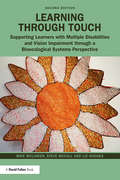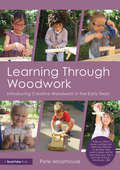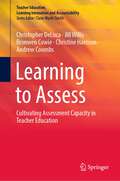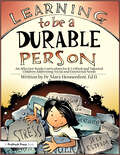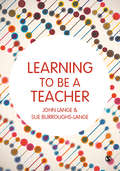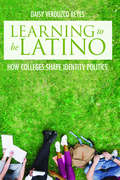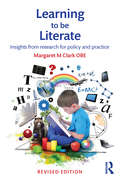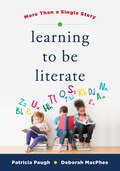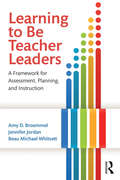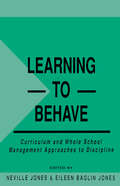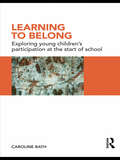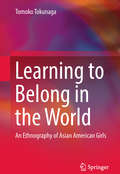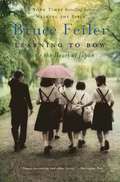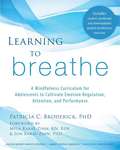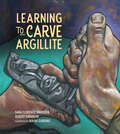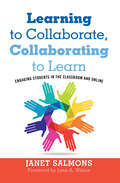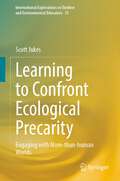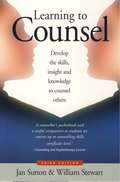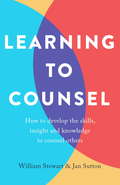- Table View
- List View
Learning through Touch: Supporting Learners with Multiple Disabilities and Vision Impairment through a Bioecological Systems Perspective
by Mike Mclinden Steve Mccall Liz HodgesThis fully revised and updated second edition of Learning through Touch is essential reading for practitioners who support learners with multiple disabilities and vision impairment. These learners will rely on support from their learning partners throughout their education to mediate their learning experiences. The text explores the key role that touch plays in the education of these learners and provides practical advice about how to develop the skills through touch that they will need to become ‘active agents’ in their own development. The book reflects international initiatives that seek to ensure that people with disabilities have opportunities to take meaningful control within their learning and their lives. Key features include: Chapters that support curriculum access for learners with visual impairments; Reflections on up-to-date research studies and guidance for further reading throughout, allowing for a strong conceptual foundation for practice; Portfolio activities designed to help implement effective learning opportunities within your own practice. Written to assist teachers and other professionals who support children with visual impairment and additional difficulties, this text will appeal to professionals and students alike. It is an invaluable resource for anyone looking to explore the role of touch in creating effective learning experiences.
Learning Through Woodwork: Introducing Creative Woodwork in the Early Years
by Pete MoorhouseThis essential guide provides clear and comprehensive support for those looking to introduce creative woodwork into early years settings. With theory, practical advice, stunning colour images and case studies, the book will inspire practitioners to embrace woodwork and encourage children’s independent creative learning. Focusing on the numerous benefits that working with wood offers young children, from boosting their self-esteem and problem-solving skills, to enhancing their communication and social development, the author draws on over 25 years of experience to discuss each and every aspect of establishing woodwork in the early years curriculum. Including practical information on materials and tools, staff training, and health and safety advice, this go-to guide provides a treasure trove of ideas to engage children at various stages of development, drawing the maximum benefit from working with wood and tools. Both inspiring and informative, Learning Through Woodwork will become an essential tool for early years practitioners and teachers wishing to explore and develop woodwork provision.
Learning to Assess: Cultivating Assessment Capacity in Teacher Education (Teacher Education, Learning Innovation and Accountability)
by Christopher DeLuca Jill Willis Bronwen Cowie Christine Harrison Andrew CoombsThis book presents a new framework for how teachers develop their assessment capacity, based on a multi-year study conducted in four countries—Australia, Canada, England, and New Zealand—which focused on student-teacher learning in assessment throughout their initial teacher education programs. It examines how teacher learning is shaped by the complex dynamics of assessment capacity within larger teacher education contexts. The framework proposed here identifies four domains involved in cultivating assessment capacity and characterizes assessment learning as always integrating cognitive, philosophical, and moral dimensions with assessment’s social, emotional, and physical dimensions, while recognizing that each capacity is continually shaped by the learning context. The book draws on the survey of teacher education programs in each of the four focal countries and data from student teachers to shed light on how the various pedagogies, program structures, and policies encountered provide beginning teachers with codes for classifying and framing assessment capacity and form a template for developing this capacity throughout their careers. Offering suggestions for future research and teacher education practice, the book concludes with an outlook on future steps to cultivate teachers’ assessment capacity.
Learning to be a Durable Person: Social and Emotional Activities and Teacher Guide (Grades K-5)
by Mary HennenfentWhat is a durable person? What traits do successful people exhibit? What is a perfectionist? These questions and many others are explored in this practical guide to helping gifted students navigate social and emotional issues in their lives. This curriculum is designed to help gifted children explore their own giftedness, expand social skills, cultivate leadership skills, and develop strategies for combatting stress, anger, and perfectionism. Gifted children must be taught to be durable so they can continue to be responsible and productive citizens. Topics covered in Learning to be a Durable Person include:Being gifted means different things to different people,Successful people exhibit the traits of creativity, goal setting, intelligence, courage and kindness,A person who chooses a career based on his or her intelligences may be more productive and satisfied in his or her career,Understanding why people tease others may allow you to choose how to deal with teasing, andNo one is perfect.Grades K-5
Learning to be a Person in Society
by Peter JarvisLearning is a lifelong process and we are the result of our own learning. But how exactly do we learn to be a person through living? In this book, Peter Jarvis draws together all the aspects of becoming a person into the framework of learning. Considering the ongoing, "nature versus nurture" debate over how we become people, Jarvis’s study of nurture - what learning is primarily about – builds on a detailed recognition of our genetic inheritance and evolutionary reality. It demonstrates the ways in which we become social human beings: internalising, accommodating and rejecting the culture to which we are exposed (both primarily and through electronic mediation) while growing and developing as human beings and people. As learning theory moves away from traditional, single-discipline approaches it is possible to place the person at the centre of all thinking about learning, by emphasising a multi-disciplinary approach. This wide-ranging study draws on established research from a number of disciplines into the complexities that make us who we are. It will appeal to a wide variety of audiences: those involved in all fields of education, the study of learning and development, human resource development, psychology, theology and the caring professions.
Learning to be a Teacher
by John Lange Sue Burroughs-LangeBeing a successful teacher means constantly examining your own development to identify blind spots and ensure you engage on a meaningful level with teaching and learning. This book discusses theoretical and conceptual ideas, linked to direct strategies for the classroom, that guide students towards becoming proactive and effective learners, giving them the confidence to take charge of their professional future in teaching. Built around a series of ‘contributing ideas', this book includes a conceptual framework for critically analysing and thinking about the teaching and learning environment. Examples throughout explore how to make the most of professional learning opportunities so students can take personal control of their learning, through self-regulation and self-monitoring. Strategies for making practical use of these ideas for classroom planning and preparation for learning are also included.
Learning to be a Teacher
by John Lange Sue Burroughs-LangeBeing a successful teacher means constantly examining your own development to identify blind spots and ensure you engage on a meaningful level with teaching and learning. This book discusses theoretical and conceptual ideas, linked to direct strategies for the classroom, that guide students towards becoming proactive and effective learners, giving them the confidence to take charge of their professional future in teaching. Built around a series of ‘contributing ideas', this book includes a conceptual framework for critically analysing and thinking about the teaching and learning environment. Examples throughout explore how to make the most of professional learning opportunities so students can take personal control of their learning, through self-regulation and self-monitoring. Strategies for making practical use of these ideas for classroom planning and preparation for learning are also included.
Learning to Be Latino: How Colleges Shape Identity Politics (Critical Issues in American Education)
by Daisy Verduzco ReyesIn Learning to Be Latino, sociologist Daisy Verduzco Reyes paints a vivid picture of Latino student life at a liberal arts college, a research university, and a regional public university, outlining students’ interactions with one another, with non-Latino peers, and with faculty, administrators, and the outside community. Reyes identifies the normative institutional arrangements that shape the social relationships relevant to Latino students’ lives, including school size, the demographic profile of the student body, residential arrangements, the relationship between students and administrators, and how well diversity programs integrate students through cultural centers and retention centers. Together these characteristics create an environment for Latino students that influences how they interact, identify, and come to understand their place on campus. Drawing on extensive ethnographic observations, Reyes shows how college campuses shape much more than students’ academic and occupational trajectories; they mold students’ ideas about inequality and opportunity in America, their identities, and even how they intend to practice politics.
Learning to be Literate: Insights from research for policy and practice
by Margaret M ClarkWinner of the prestigious UK Literacy Association Academic Book Award for 2015 in its original edition, this fully revised edition of Learning to be Literate uniquely analyses research into literacy from the 1960s through to 2015 with some surprising conclusions. Margaret Clark explores the argument that young children growing up in a literate environment are forming hypotheses about the print around them, including environmental print, television, computer games and mobile phones. In a class where no child can yet read there is a wide range of understanding with regards to concepts of print and the critical features of written language. While to any literate adult, the relationship between spoken and written language may be obvious, young children have to be helped to discover it. This persuasive argument demonstrates the value of research in order to make informed policy decisions about children’s literacy development. Accessible and succinct, Professor Clark’s writing brings into sharp focus the processes involved in becoming literate. The effect on practice of many recent government policies she claims run counter to these insights. The key five thematic sections are backed up with case studies throughout and include: Insights from Literacy Research: 1960s to 1980s Young Literacy Learners: how we can help them Curriculum Developments and Literacy Policies, 1988 to 1997: a comparison between England and Scotland Synthetic Phonics and Literacy Learning: government policy in England 2006 to 2015 Interpretations of Literacy in the Twenty-first Century
Learning to Be Literate: More Than a Single Story
by Deborah MacPhee Patricia PaughThere is not one right way to teach a child to read. Recent media stories about education have featured the “Science of Reading,” whose proponents typically present the systematic teaching of phonics as a one-size-fits-all method that guarantees reading success for all students. But as literacy scholars Patricia Paugh and Deborah MacPhee demonstrate, the decoding of words is only one of many skills that are central to an effective early literacy education. In Learning to Be Literate, they present a four-part framework for active literacy learning that eschews oppositional arguments about different approaches, and instead situates children as meaning makers: the whole point of being literate. There is no single or simple solution that will fit every child. But by using the ALL framework to inform instruction, educators can help young learners think deeply about ideas and language at the same time as they learn to work out the sounds and symbol systems of language.
Learning to Be Teacher Leaders: A Framework for Assessment, Planning, and Instruction
by Jennifer Jordan Amy D. Broemmel Beau Michael WhitsettLearning to Be Teacher Leaders examines three integrated components of strong pedagogy—assessment, planning, and instruction—within a framework emphasizing the knowledge, skills, and dispositions that can empower teachers to become teacher leaders within their schools. Combining the what, why, and how of teaching, the research-based concepts, presented in a pragmatic format, are relevant across grade levels, classrooms, and content areas. Designed to support success on national licensure assessments, this text brings together in one place the important features of learning to be an effective teacher, and becoming a teacher leader who continues to grow and develop within the profession. Taking a student-centered approach to instruction, it also recognizes the outside factors that can challenge this approach and provides strategies for coping with them. Using this book as a guide and resource, pre-service and beginning teachers will focus on the most important factors in teaching, resulting in strengthening their pedagogy and developing a language that helps them move forward in terms of agency and advocacy. A Companion Website provides additional resources for instructors and students.
Learning to Behave: Curriculum and Whole School Management Approaches to Discipline
by Neville Jones Eileen Baglin JonesOffering up-to-date research on school discipline and bullying, this study emphasizes the management of school discipline through school policies and the responsibility of problems by all members of staff. It gives examples of curriculum initiatives that address pupils with discipline problems.
Learning to Belong: Exploring Young Children's Participation at the Start of School
by Caroline BathBuilding on highly topical research surrounding young children’s participation, this book draws on a diversity of disciplines exploring the importance of participatory approaches to children’s early education and shows how fostering a sense of identity and belonging are essential to early learning. Taking young children seriously demands a high level of confidence and leadership in early years practitioners, and the author provides a convincing, well researched rationale for using this approach in early years contexts. The chapters • demonstrate the importance of listening to the voices of the children,• show how to help young children make sense of the rules and hierarchies they encounter in the classroom• explore ways of working that include the young children but also allow adults to shape approaches to collective decision making • use examples of the type of questions which children might ask when they first enter school, which are presented as ‘windows’ into children’s experiences via key moments or incidents in the school day• provide a framework and practical tools for planning This book is an important addition to debate about the politics and ethics of a highly prescribed and mainly developmentally-informed early years curriculum. Researchers and students of early childhood education will find much here of interest to them.
Learning to Belong in the World: An Ethnography Of Asian American Girls
by Tomoko TokunagaThis book provides a complex and intricate portrayal of Asian American high school girls – which has been an under-researched population – as cultural meditators, diasporic agents, and community builders who negotiate displacement and attachment in challenging worlds of the in-between. Based on two years of ethnographic fieldwork, Tomoko Tokunaga presents a portrait of the girls’ hardships, dilemmas, and dreams while growing up in an interconnected world. This book contributes a new understanding of the roles of immigrant children and youth as agents of globalization and sophisticated border-crossers who have the power and agency to construct belonging and identity across multiple contexts, spaces, times, activities, and relationships. It has much to offer to the construction of educative communities and spaces where immigrant youth, specifically immigrant girls, can thrive.
Learning to Bow
by Bruce FeilerLearning to Bow has been heralded as one of the funniest, liveliest, and most insightful books ever written about the clash of cultures between America and Japan. With warmth and candor, Bruce Feiler recounts the year he spent as a teacher in a small rural town. Beginning with a ritual outdoor bath and culminating in an all-night trek to the top of Mt. Fuji, Feiler teaches his students about American culture, while they teach him everything from how to properly address an envelope to how to date a Japanese girl.
Learning to Bow
by Bruce FeilerLearning to Bow has been heralded as one of the funniest, liveliest, and most insightful books ever written about the clash of cultures between America and Japan. With warmth and candor, Bruce Feiler recounts the year he spent as a teacher in a small rural town. Beginning with a ritual outdoor bath and culminating in an all-night trek to the top of Mt. Fuji, Feiler teaches his students about American culture, while they teach him everything from how to properly address an envelope to how to date a Japanese girl.
Learning To Breathe: A Mindfulness Curriculum For Adolescents To Cultivate Emotion Regulation, Attention, And Performance
by Patricia Broderick Myla Kabat-Zinn Jon Kabat-ZinnDisruptive behavior in the classroom, poor academic performance, out-of-control emotions: if you work with adolescents, you are well-aware of the challenges this age group presents. What if there was a way to calm these students down and arm them with the mindfulness skills needed to really excel in school and life? <p><p> Written by mindfulness expert and licensed clinical psychologist Patricia C. Broderick, Learning to Breathe is a secular program that tailors the teaching of mindfulness to the developmental needs of adolescents to help them understand their thoughts and feelings and manage distressing emotions. Students will be empowered by learning important mindfulness meditation skills that help them improve emotion regulation, reduce stress, improve overall performance, and, perhaps most importantly, develop their attention. The book also includes a website link with student handouts and homework assignments, making it an ideal classroom tool. <p> The book integrates certain themes of mindfulness-based stress reduction (MBSR), developed by Jon Kabat-Zinn, into a program that is shorter, more accessible to students, and compatible with school curricula. Students will learn to pay attention in the moment, manage emotions as they are perceived, and gain greater control over their own feelings and actions. These mindfulness practices offer the opportunity to develop hardiness in the face of uncomfortable feelings that otherwise might provoke a response that could be harmful (e.g. acting out by taking drugs, displaying violent behavior or acting in by becoming more depressed). <p> This easy-to-use manual is designed to be used by teachers, but can also be used by any mental health provider teaching adolescents emotion regulation, stress reduction and mindfulness skills. The author is a graduate of the MBSR advanced practicum at the Center for Mindfulness in Massachusetts, led by Jon Kabat-Zinn. She is also a clinical psychologist and a certified school psychologist and counselor for grades K-12. In the book, Broderick calls on her years of experience working with adolescents to outline the best strategies for dealing with disruption in the classroom and emotions that are out of hand. <p> The book is structured around six themes built upon the acronym BREATHE, and each theme has a core message. The program allows for themes to be delivered in 6 longer or 18 shorter sessions, depending upon time and needs of students. The 6 core lessons are: Body, Reflection, Emotions, Attention, Tenderness, and Healthy Mind Habits. <p> Learning to Breathe is the perfect tool for empowering students as they grapple with the psychological tasks of adolescence.
Learning to Carve Argillite (Sk'ad'a Stories Series)
by Sara Florence Davidson Robert DavidsonBased on Haida artist Robert Davidson's own childhood experiences, this beautiful story highlights learning through observation, as well as the role of Elders in sharing knowledge and mentorship.Learning to carve is a lifelong journey. With the help of his father and grandfather, a boy on Haida Gwaii practises to become a skillful carver. As he carefully works on a new piece, he remembers a trip to Slatechuck Mountain to gather the argillite, as well as his father&’s words about the importance of looking back to help us find our way.Written by the creators of Potlatch as Pedagogy, this book brings the Sk'ad'a Principles to life through the art of Janine Gibbons.
Learning to Carve Argillite (Sk'ad'a Stories Series)
by Sara Florence Davidson Robert DavidsonBased on Haida artist Robert Davidson's own childhood experiences, this beautiful story highlights learning through observation, as well as the role of Elders in sharing knowledge and mentorship.Learning to carve is a lifelong journey. With the help of his father and grandfather, a boy on Haida Gwaii practises to become a skillful carver. As he carefully works on a new piece, he remembers a trip to Slatechuck Mountain to gather the argillite, as well as his father&’s words about the importance of looking back to help us find our way.Written by the creators of Potlatch as Pedagogy, this book brings the Sk'ad'a Principles to life through the art of Janine Gibbons.
Learning to Change Lives
by A. Ka TsangThe Strategies and Skills Learning and Development (SSLD) system is an action-oriented model for enabling clients in social work, health, mental health, and human services settings to address their needs and life goals. In Learning to Change Lives, author A. Ka Tat Tsang introduces SSLD's powerful framework and practice, which has been developed based on three decades of experience in psychotherapy, counselling, education, training, consultation, and community service.Learning to Change Lives provides detailed, step-by-step guidelines for SSLD intervention - starting with engagement with the client, assessment, translating problems into intervention plans, systematic learning and development of appropriate strategies and skills. Key practice procedures are described clearly and illustrated by case examples, specific instructions, and sample worksheets. Aimed at clinical practitioners, mental health professionals, social workers, and other human service professionals, this book can be used as a manual by practitioners and as a textbook for courses and training programs.
Learning to Collaborate, Collaborating to Learn: Engaging Students in the Classroom and Online
by Janet SalmonsStudents who know how to collaborate successfully in the classroom will be better prepared for professional success in a world where we are expected to work well with others. Students learn collaboratively, and acquire the skills needed to organize and complete collaborative work, when they participate in thoughtfully-designed learning activities.Learning to Collaborate, Collaborating to Learn uses the author’s Taxonomy of Online Collaboration to illustrate levels of progressively more complex and integrated collaborative activities.- Part I introduces the Taxonomy of Online Collaboration and offers theoretical and research foundations.- Part II focuses on ways to use Taxonomy of Online Collaboration, including, clarifying roles and developing trust, communicating effectively, organizing project tasks and systems.- Part III offers ways to design collaborative learning activities, assignments or projects, and ways to fairly assess participants’ performance.Learning to Collaborate, Collaborating to Learn is a professional guide intended for faculty, curriculum planners, or instructional designers who want to design, teach, facilitate, and assess collaborative learning. The book covers the use of information and communication technology tools by collaborative partners who may or may not be co-located. As such, the book will be appropriate for all-online, blended learning, or conventional classrooms that infuse technology with “flipped” instructional techniques.
Learning to Confront Ecological Precarity: Engaging with More-than-human Worlds (International Explorations in Outdoor and Environmental Education #13)
by Scott JukesThis volume presents innovative approaches for confronting environmental issues and socio-ecological inequality within Outdoor Environmental Education (OEE). Through experimentation with alternative pedagogical possibilities, it explores what OEE can do in response to ecological precarity. Drawing upon posthumanist theory, it focuses on the enactment of more-than-human pedagogies that foster affirmative environmental relationships while challenging problematic cultural perspectives. The 12 chapters explore various topics, including place-responsive pedagogies, environmental stories, new materialist theoretical insights and waste education practices, engaging with complex environmental issues such as species extinction and climate change in the context of OEE. This book provides practical examples and conceptual creativity to extend contemporary theoretical currents. It offers innovative pedagogical strategies and methodological insights for OEE. Researchers, students, and practitioners of OEE interested in applying posthumanist ideas to their work will find this volume most interesting.
Learning To Counsel, 4th Edition: Develop The Skills, Insight And Knowledge To Counsel Others
by William Stewart Jan Suttonhe new edition of this popular and userfriendly book has been thoughtfully revised, updated and expanded. Fresh informationhas been added to keep pace with the rapidly advancing field of counselling and psychotherapy.Learning to Counsel, Third Edition, contains an abundance of illustrative graphics, case studies, examples of skills in practice, practical exercises, and sample letters, forms and checklists designed to stimulate learning. Its predecessor appears onthe recommended reading list of several counselling certificate courses.This new revised edition is an ideal text for those contemplating embarking on a counselling course, trainee counsellors, counselling tutors to use in training, professionals working in the area of health care, management, and education, and counsellors working in the voluntary sector.Contents: Illustrations, table, sample forms and letters; Foreword; Preface; 1. Exploring Counselling; 2. Exploring Essential Counsellor Qualities; 3. Developing Self-Awareness; 4. Helping the Client Feel Safe; 5. Helping the Client Explore the Problem (Part 1); 6. Helping the Client Explore the Problem (Part 2); 7. Helping the Client Understand the Problem; 8. Helping the Client Resolve the Problem; 9. Terminating the Counselling Relationship; 10. Counsellor Self-Care; Appendix 1 Sample Forms and Letters; Appendix 2 Suggested Responses to Exercises; Appendix 3 Important People in the Development of Counselling; Glossary; Useful Websites; Further Reading; Index.
Learning To Counsel, 4th Edition: How to develop the skills, insight and knowledge to counsel others
by William Stewart Jan SuttonDrawing on their numerous years experience as counsellors, tutors, and writers, Jan Sutton and William Stewart introduce readers to the basic principles that underpin counselling practice. Written in a clear, concise and jargon-free style, and with its wealth of case studies, examples of skills in practice, and practical exercises, this new edition is an ideal text for those embarking on a counselling or psychotherapy course, trainee counsellors, counselling tutors to use in training, professionals working in the area of health care, management and education, and counsellors working in the voluntary sector. It provides insight into various counselling approaches; clarifies the nature of counselling and the role of the counsellor, and assists readers to develop a repertoire of key counselling skills and qualities, such as active listening, genuineness, unconditional positive regard, empathy, goal-setting, etc. The book also addresses the important issues of ongoing supervision to enhance counselling practice, and counsellor self-care to reduce the risk of burnout.
Learning To Counsel, 4th Edition: How to develop the skills, insight and knowledge to counsel others
by Jan Sutton William StewartDrawing on their numerous years experience as counsellors, tutors, and writers, Jan Sutton and William Stewart introduce readers to the basic principles that underpin counselling practice. Written in a clear, concise and jargon-free style, and with its wealth of case studies, examples of skills in practice, and practical exercises, this new edition is an ideal text for those embarking on a counselling or psychotherapy course, trainee counsellors, counselling tutors to use in training, professionals working in the area of health care, management and education, and counsellors working in the voluntary sector. It provides insight into various counselling approaches; clarifies the nature of counselling and the role of the counsellor, and assists readers to develop a repertoire of key counselling skills and qualities, such as active listening, genuineness, unconditional positive regard, empathy, goal-setting, etc. The book also addresses the important issues of ongoing supervision to enhance counselling practice, and counsellor self-care to reduce the risk of burnout.
